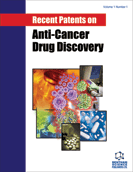Abstract
This review focuses on the recent patents and use of small-molecule inhibitors (SMIs) of Bcl-2 family proteins as therapeutic agents against cancer. Bcl-2 members are crucial regulators of apoptotic cell death. Apoptosis is an evolutionarily conserved process of programmed cell death that plays an essential role in organism development and tissue homeostasis. Several mechanisms exist allowing cells to escape programmed cell death among them is the overexpression of the antiapoptotic proteins. Cancer cells are often found to overexpress many of these members such as Bcl-2, Bcl-XL, Mcl-1, Bcl-w and A1/Bfl1 and are usually resistant to a wide range of anti-cancer drugs and treatments. Many groups have been working to develop anti-cancer drugs that block the function of anti-apoptotic Bcl-2 members, thus favoring cell death. Methods include the downregulation of Bcl-2 expression or the use of peptides or small organic molecules to the Bcl-2 binding pocket, preventing its sequestration of proapoptotic proteins such as Bid and Bim. One of the most promising aspects of SMIs in treating cancer is that their targets and mechanisms of action are different from those of cytotoxic drugs and radiation. This makes it feasible to combine SMIs with other treatments, creating a synergistic therapy, without likely development of cross-resistance or increased toxicity. A broad-spectrum or “pan” SMI which targets multiple Bcl-2 family proteins is the goal.
Keywords: Bcl-2, Bcl-XL, Mcl-1, Bcl-w, A1/Bfl1, therapeutic gents, cancer, Bcl-2 expression
Recent Patents on Anti-Cancer Drug Discovery
Title: Small-Molecule Inhibitors of Bcl-2 Family Proteins as Therapeutic Agents in Cancer
Volume: 3 Issue: 1
Author(s): Ramzi Mohammad, Anshu Giri and Anton-Scott Goustin
Affiliation:
Keywords: Bcl-2, Bcl-XL, Mcl-1, Bcl-w, A1/Bfl1, therapeutic gents, cancer, Bcl-2 expression
Abstract: This review focuses on the recent patents and use of small-molecule inhibitors (SMIs) of Bcl-2 family proteins as therapeutic agents against cancer. Bcl-2 members are crucial regulators of apoptotic cell death. Apoptosis is an evolutionarily conserved process of programmed cell death that plays an essential role in organism development and tissue homeostasis. Several mechanisms exist allowing cells to escape programmed cell death among them is the overexpression of the antiapoptotic proteins. Cancer cells are often found to overexpress many of these members such as Bcl-2, Bcl-XL, Mcl-1, Bcl-w and A1/Bfl1 and are usually resistant to a wide range of anti-cancer drugs and treatments. Many groups have been working to develop anti-cancer drugs that block the function of anti-apoptotic Bcl-2 members, thus favoring cell death. Methods include the downregulation of Bcl-2 expression or the use of peptides or small organic molecules to the Bcl-2 binding pocket, preventing its sequestration of proapoptotic proteins such as Bid and Bim. One of the most promising aspects of SMIs in treating cancer is that their targets and mechanisms of action are different from those of cytotoxic drugs and radiation. This makes it feasible to combine SMIs with other treatments, creating a synergistic therapy, without likely development of cross-resistance or increased toxicity. A broad-spectrum or “pan” SMI which targets multiple Bcl-2 family proteins is the goal.
Export Options
About this article
Cite this article as:
Mohammad Ramzi, Giri Anshu and Goustin Anton-Scott, Small-Molecule Inhibitors of Bcl-2 Family Proteins as Therapeutic Agents in Cancer, Recent Patents on Anti-Cancer Drug Discovery 2008; 3 (1) . https://dx.doi.org/10.2174/157489208783478676
| DOI https://dx.doi.org/10.2174/157489208783478676 |
Print ISSN 1574-8928 |
| Publisher Name Bentham Science Publisher |
Online ISSN 2212-3970 |
Related Books
 32
32
- Author Guidelines
- Bentham Author Support Services (BASS)
- Graphical Abstracts
- Fabricating and Stating False Information
- Research Misconduct
- Post Publication Discussions and Corrections
- Publishing Ethics and Rectitude
- Increase Visibility of Your Article
- Archiving Policies
- Peer Review Workflow
- Order Your Article Before Print
- Promote Your Article
- Manuscript Transfer Facility
- Editorial Policies
- Allegations from Whistleblowers
Related Articles
-
Combining Gene Therapy and Radiation Against Cancer
Current Gene Therapy Nitric Oxide: Target for Therapeutic Strategies in Alzheimers Disease
Current Pharmaceutical Design Anti-MDR Effects of Quercetin and its Nanoemulsion in Multidrug-Resistant Human Leukemia Cells
Anti-Cancer Agents in Medicinal Chemistry <sup>177</sup>Lu-Labeled Agents for Neuroendocrine Tumor Therapy and Bone Pain Palliation in Uruguay
Current Radiopharmaceuticals Melatonin and Synthetic Melatoninergic Agonists in Psychiatric and Age-associated Disorders: Successful and Unsuccessful Approaches
Current Pharmaceutical Design Drug Delivery Across the Blood-Brain Barrier
Current Nanoscience TRIM65 in White Matter Lesions, Innate Immunity, and Tumor
Current Molecular Pharmacology Pharmacogenetics and Inflammatory Bowel Disease
Current Pharmacogenomics and Personalized Medicine Tetrahydrobioterin (BH4) Pathway: From Metabolism to Neuropsychiatry
Current Neuropharmacology BRCA-FA Pathway as a Target for Anti-Tumor Drugs
Anti-Cancer Agents in Medicinal Chemistry Interactions Between Cholinergic and Fibroblast Growth Factor Receptors in Brain Trophism and Plasticity
Current Protein & Peptide Science Targeted Toxins for Glioblastoma Multiforme: Pre-Clinical Studies and Clinical Implementation
Anti-Cancer Agents in Medicinal Chemistry Zinc Dependent Histone Deacetylase Inhibitors in Cancer Therapeutics: Recent Update
Current Medicinal Chemistry Will Arsenic Trioxide Benefit Treatment of Solid Tumor by Nano- Encapsulation?
Mini-Reviews in Medicinal Chemistry Taxotere Chemosensitivity Evaluation in Rat Breast Tumor by Multimodal Imaging: Quantitative Measurement by Fusion of MRI, PET Imaging with MALDI and Histology
Recent Patents on Medical Imaging 19F: A Versatile Reporter for Non-Invasive Physiology and Pharmacology Using Magnetic Resonance
Current Medicinal Chemistry Rotundic Acid Regulates the Effects of Let-7f-5p on Caco2 Cell Proliferation
Anti-Cancer Agents in Medicinal Chemistry Targeting Proteasomes with Naturally Occurring Compounds in Cancer Treatment
Current Cancer Drug Targets Sialic Acid and the Central Nervous System: Perspectives on Biological Functions, Detection, Imaging Methods and Manipulation
CNS & Neurological Disorders - Drug Targets Microwave Assisted Synthesis, Biological Characterization and Docking Studies of Pyrimidine Derivatives
Current Microwave Chemistry


























